An unexpected surprise in the mail
Checking the mail this morning, I found an unexpected letter.
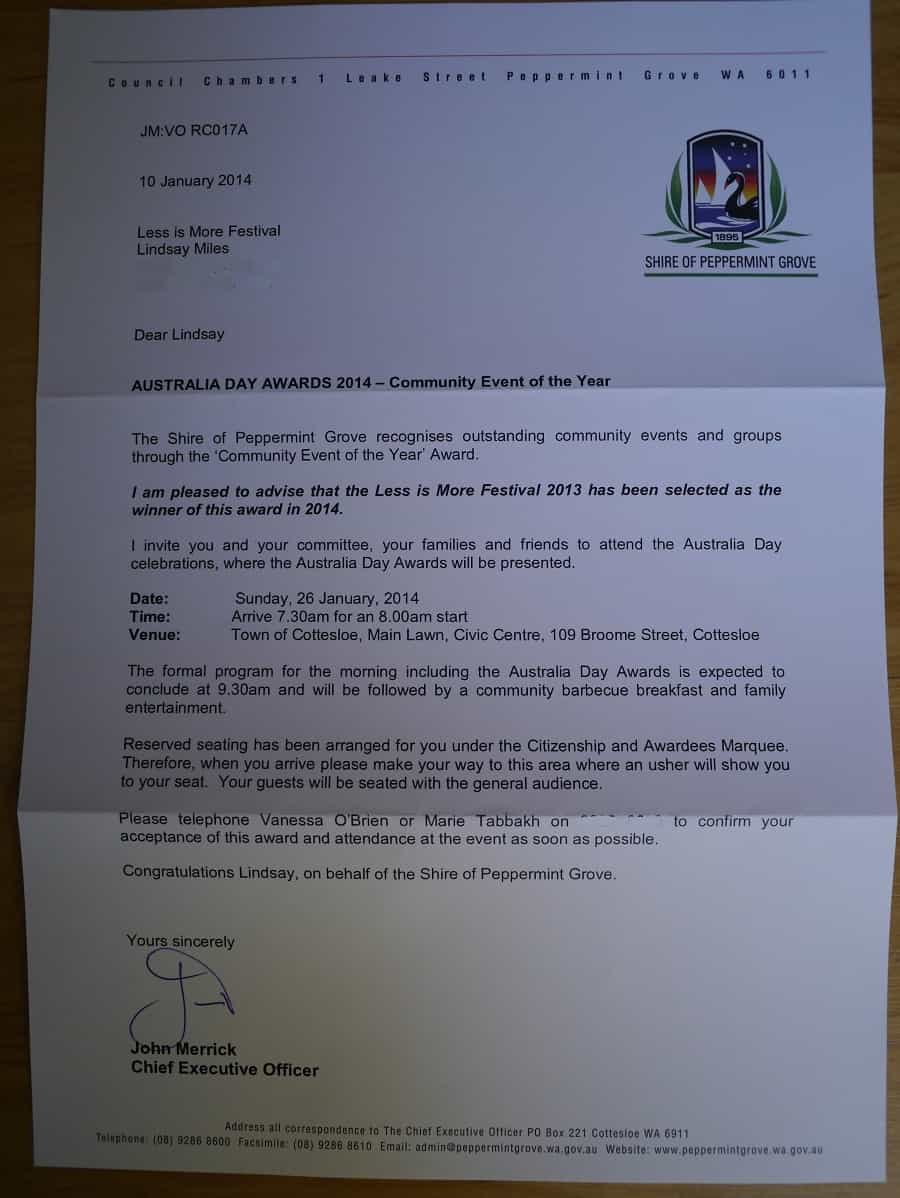 The community event I organised last year has won an award! How exciting is that?! Read more
The community event I organised last year has won an award! How exciting is that?! Read more
Checking the mail this morning, I found an unexpected letter.
 The community event I organised last year has won an award! How exciting is that?! Read more
The community event I organised last year has won an award! How exciting is that?! Read more
We’re now into the third week of 2014, and so far on the blog all I’ve talked about is 2013. I need to get with the times, so this will be the final post I write that dwells on what is now behind us. Enough of living in the past, I say!
Holidays and the start of a New Year are great times to start making plans for how we want the next part of our lives to be. All the things we want to do, to see, to learn, to experience, to feel. I love to plan, and in previous years I would go charging ahead into dreaming and scheming. This year though (or last year, technically), I slowed down. I decided to spend some time reflecting on the year that just passed before I started thinking about what’s next. Specifically, I thought about all the things that I did that I was proud of in 2013. My achievements. Read more
My goal was to travel around Thailand for four weeks without consuming any single use plastic. It’s what I do at home, so why should anything be different whilst I was away? I’ve already talked about how I avoided using disposable water bottles, which I thought would be the biggest battle. But there were other contenders.
The plastic straw
Thai people love straws. I thought the straw problem was bad in Australia, but there is a whole other level of straw-dependence over there. Every single drink seems to come with a straw. Of course the obvious smoothies and cocktails come with plastic straws. But less obvious drinks come with them too. If you buy bottled water to take away, it comes in a plastic bag and with a straw. If you buy a tin of fizzy pop, a straw is neatly tucked under the ring pull. Even tins of iced coffee and beer come with straws. It seems that the cultural norm is to drink your drink with a straw. Everyone does it.
Except, we didn’t want to use plastic straws.
I don’t know how to say “please don’t give me a plastic straw” in Thai. Fortunately, this didn’t matter, because I’d brought a stainless steel reusable straw with me from home. It was the single most used item on the trip. Whenever I purchased a drink, I’d whip out my straw and demonstrate that I had one, and no straw would come with the drink. I’m sure they all thought I was a crazy Westerner, but at least I was keeping to the local custom!
There were a couple of occasions where the staff forgot (there were two times that I can remember) and brought me a straw. I handed them back immediately unused, hoping that the straws would be washed and reused, but of course, they went in the bin. So usually I’d watch as staff prepared my drink, and if I saw any hands heading near the straws I’d run over, flailing my arms in the air until they panicked and handed the straw-free beverage over. I may have looked mad, but it worked.
The plastic bag
The plastic bag is the other obvious contender, and you’d be forgiven for thinking it would be pretty easy to avoid these. Just say no when you buy something, right? But there were a couple of complications.
The first was laundry. In Thailand self-serve laundromats aren’t very common, and instead people offer a private laundry service where you pay by weight. You drop your laundry off and pick it up 24 hours later, smelling fragrant, neatly pressed… and folded in a plastic bag. It’s not like we could not use a bag altogether, because we’d have ended up dropping our underpants and socks all the way down the street. Fortunately we had brought a calico bag with us and we were able to use this instead.
The second was that Thai people used plastic bags as a vessel for food and drink. Literally. They pour cold drinks, hot soups, curry, sauces, coconut milk, you name it, into plastic bags, seal them up, and send you on your way.
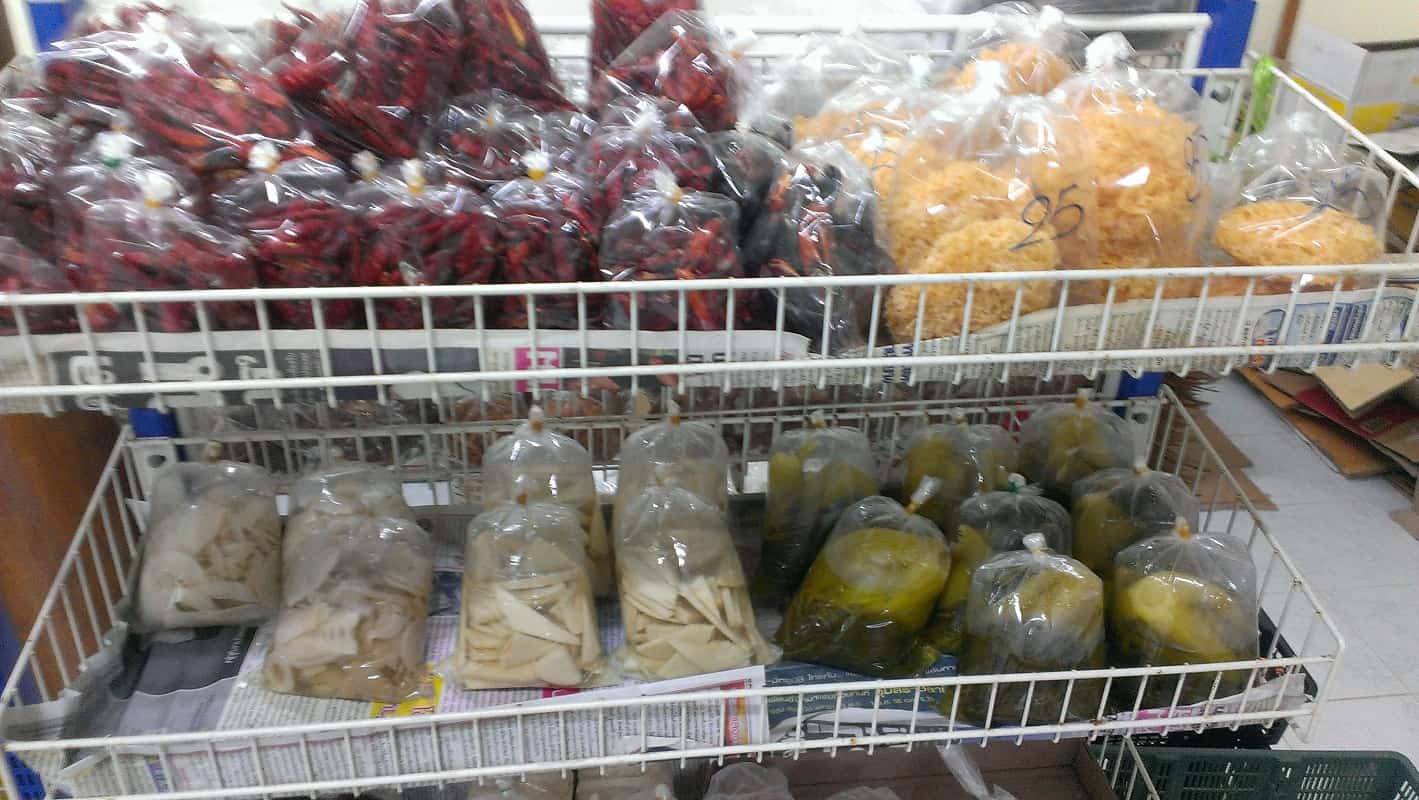 There’s no way I’d want to eat or drink anything served that’s been transported and stored in a plastic bag, even if I hadn’t given up plastic. Fortunately, our KeepCups served as containers for food, so the few times we bought something as takeaway, we didn’t need to use plastic bags.
There’s no way I’d want to eat or drink anything served that’s been transported and stored in a plastic bag, even if I hadn’t given up plastic. Fortunately, our KeepCups served as containers for food, so the few times we bought something as takeaway, we didn’t need to use plastic bags.
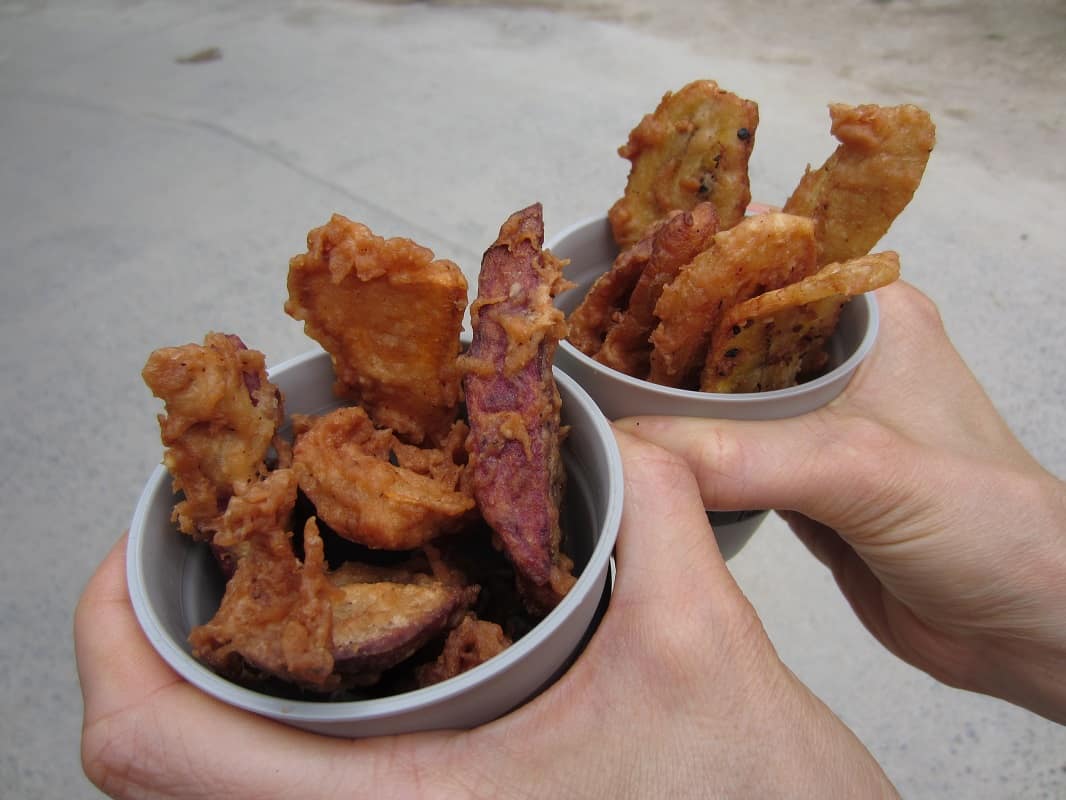
Battered, deep-fried sweet potato and banana – so delicious! We used our KeepCups rather than any disposable packaging.
The most important place to avoid plastic is at the beach. There are no bins so the options for rubbish disposal are taking it home, leaving it there or burying it. Of course, with the last two, it’s only a matter of time before it gets washed out to sea. Best to avoid disposable plastic altogether!
Other Disposables
The main other disposable plastics that we were faced with were styrofoam trays (for takeaway food items) and plastic cutlery (for takeaway food items). We avoided using plastic cutlery by taking our own re-usable bamboo cutlery. The spoon was useful for ice cream and getting all the tasty coconut meat out of the drinking coconuts once they were empty, and I even managed to skin and chop up a whole mango with the knife!
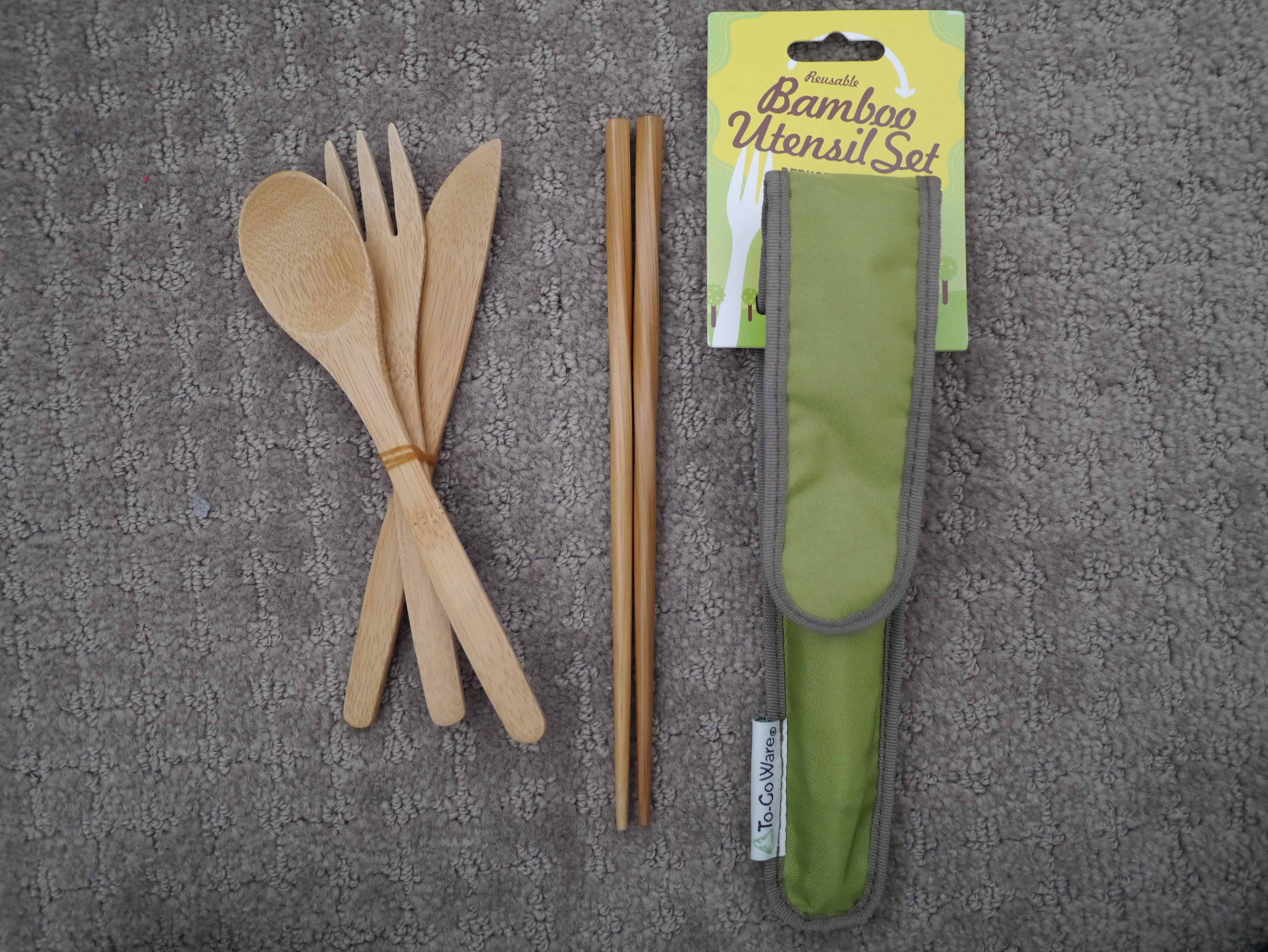 As for styrofoam, and any disposable food packaging, we avoided this by choosing to dine in rather than get takeaway. The food was fresher, we got to sit down and use metal cutlery and it looked so much more appetizing on a plate rather than stuffed in a plastic bag or cling-wrapped in styrofoam.
As for styrofoam, and any disposable food packaging, we avoided this by choosing to dine in rather than get takeaway. The food was fresher, we got to sit down and use metal cutlery and it looked so much more appetizing on a plate rather than stuffed in a plastic bag or cling-wrapped in styrofoam.
Tips for Keeping Plastic-Free
There was a lot of plastic to avoid as so much stuff was packaged this way, but keeping plastic-free didn’t mean going without, it just meant looking a little bit harder for what we wanted.
I took a reusable straw, a reusable cutlery set, a KeepCup (which is a coffee cup with a lid that can double up as a small container), a cloth bag and my water bottle. All of these were invaluable. The only additional thing I’d take if I went back is a small sealable plastic container (Tupperware or similar), because the KeepCups were a little too small for most food.
 Amongst all the plastic out there, there were plastic-free options, which were exciting to find! These bananas were barbequed, pressed and smothered in coconut sauce, and then served on banana leaves. Plastic-free definitely makes things taste more delicious!
Amongst all the plastic out there, there were plastic-free options, which were exciting to find! These bananas were barbequed, pressed and smothered in coconut sauce, and then served on banana leaves. Plastic-free definitely makes things taste more delicious!
[leadpages_leadbox leadbox_id=1429a0746639c5] [/leadpages_leadbox]
I’ve spent the last 18 months committed to avoiding unnecessary plastic. My food shopping is almost entirely plastic-free, and I especially don’t buy bottled water. Why would I, when safe drinking water comes out of my tap?
In Asia, however, the water that comes out of the tap is not safe to drink. The locals don’t drink it, and tourists shouldn’t either. When we decided to spend four weeks holidaying in Thailand at the end of last year, I really wanted to keep our plastic-free commitment and avoid buying bottled water in disposable containers. A holiday is no reason to throw our values and beliefs out the window! I just wasn’t sure how achievable it would be.
Turns out, I shouldn’t have worried! With a little bit of effort, avoiding using endless plastic drinking bottles on holiday was easy!
No expensive equipment required
Before we went away, I had a brief look at the water filters, water treatment tablets and other gadgets on the market. There’s plenty of options out there, from UV filters that zap bugs and parasites, to physical filters to remove debris, to the traditional water purification tablets. However, it’s not super straightforward. Ideally you need a bug-destroying filter and a physical filter, and the UV filters need recharging and will eventually run out. The traditional tablets involve using nasty chemicals so aren’t ideal for daily use. Plus these fancypants gadgets have fancy price labels too, and it didn’t feel right to buy more stuff that we’d use for such a short amount of time. If we had been going away for several months, or going into the wilderness maybe it would have been a worthwhile investment, but we weren’t.
And actually, we managed just fine without.
Be prepared
We didn’t buy any new gadgets, but we did take our two metal water bottles, two KeepCups and our two reusable collapsible plastic bottles – things we already had at home. I wouldn’t go anywhere in the Australian summer without taking my water bottle, so it made complete sense to take it with me.
It was a wise decision: all three were used regularly and if I went back, I’d take them all again. The bottles were useful right from when we arrived at the airport – both Perth and Bangkok airports had water filters once we’d passed through security so we could refill our empty bottles.
Make it a priority
Like most things to do with waste, it all comes down to convenience. There’s often an alternative way, even though it may require a little more effort than the conventional way. It’s all about priorities. So we prioritised, and made finding safe drinking water the first thing we did when we moved on to somewhere new.
We didn’t have too much planned when we jetted off, but I had booked our first night and last night accommodation in Bangkok, and I’d researched places that appeared to have genuine environmental policies and a focus on sustainability. This paid off: both places offered plastic-free drinking water, and we were able to refill our bottles hassle-free.
Find out what the locals do
Locals don’t drink the tap water, but they don’t all guzzle mineral water from plastic bottles either. So what do they do? In Thailand (at least in the places we visited), companies deliver treated water in big 20 litre drums to households and businesses, and the containers are returned for refilling once they are empty.
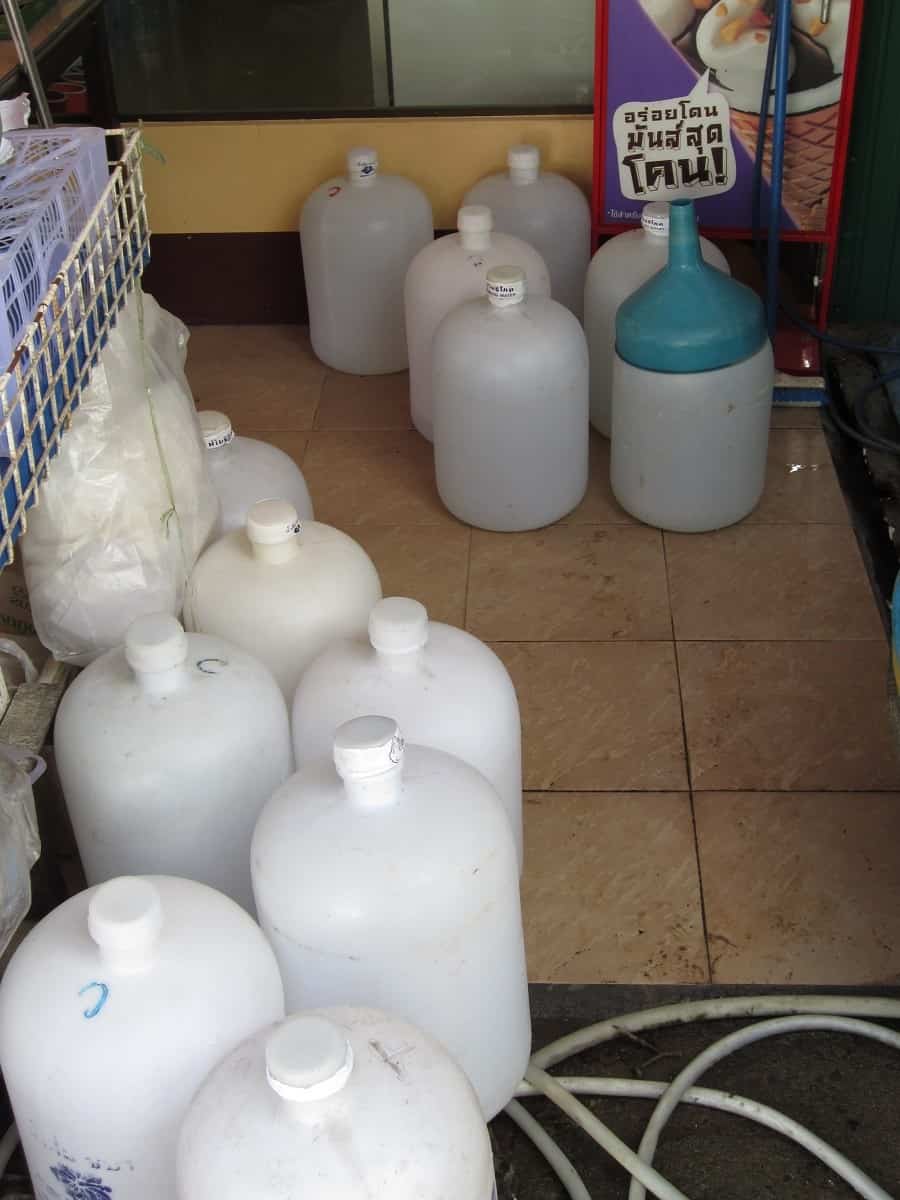 These containers aren’t marketed to tourists, and the empty containers need returning to the seller, so some retailers were reluctant to part with them. The first place we found would only let us fill up our own containers using their funnel, so we purchased one plastic 6 litre water container and used this for refills. This was our only plastic bottle purchase of the trip! There was no way we would have managed without it, either. We used this to decant the water into our little drinking bottles so we didn’t end up spilling it everywhere.
These containers aren’t marketed to tourists, and the empty containers need returning to the seller, so some retailers were reluctant to part with them. The first place we found would only let us fill up our own containers using their funnel, so we purchased one plastic 6 litre water container and used this for refills. This was our only plastic bottle purchase of the trip! There was no way we would have managed without it, either. We used this to decant the water into our little drinking bottles so we didn’t end up spilling it everywhere.
The second place we needed to use these, we found a seller willing to give us our own bottle by paying a deposit, which we got back once we returned the empty container.
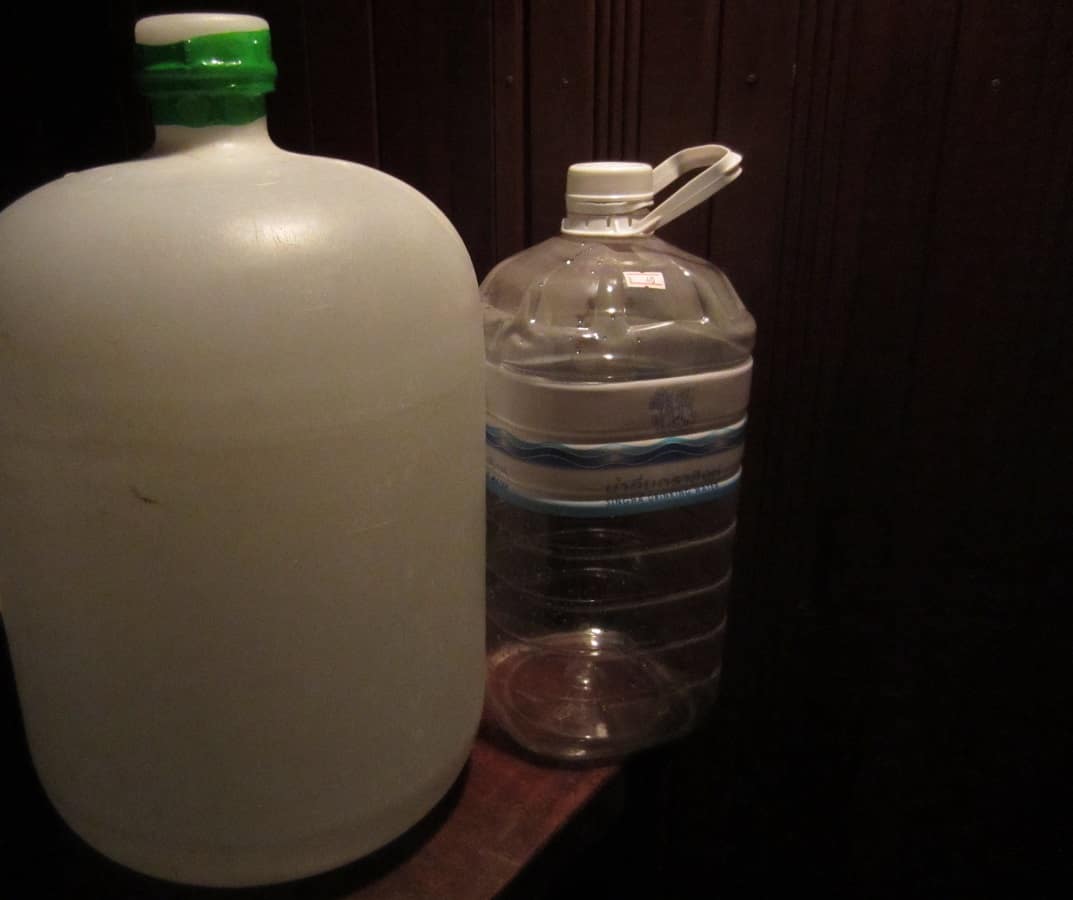
20-litre water drum with the 6-litre water bottle we had to buy. Still, that purchase meant we didn’t have to buy any more plastic bottles on our trip.
Look for alternatives
If our water bottles were empty and we were away from our base and unable to refill them, we found we still had options, and there was no need to reach for the plastic. One alternative which comes in completely biodegradable packaging is drinking coconuts. They are very hydrating, refreshing and good for you, and in Thailand, they are available everywhere.
 Lots of the cheaper Thai restaurants (which catered predominantly for locals rather than tourists) offer drinking water free of charge to patrons. We’d look out for restaurants with this service and try to use them where we could.
Lots of the cheaper Thai restaurants (which catered predominantly for locals rather than tourists) offer drinking water free of charge to patrons. We’d look out for restaurants with this service and try to use them where we could.
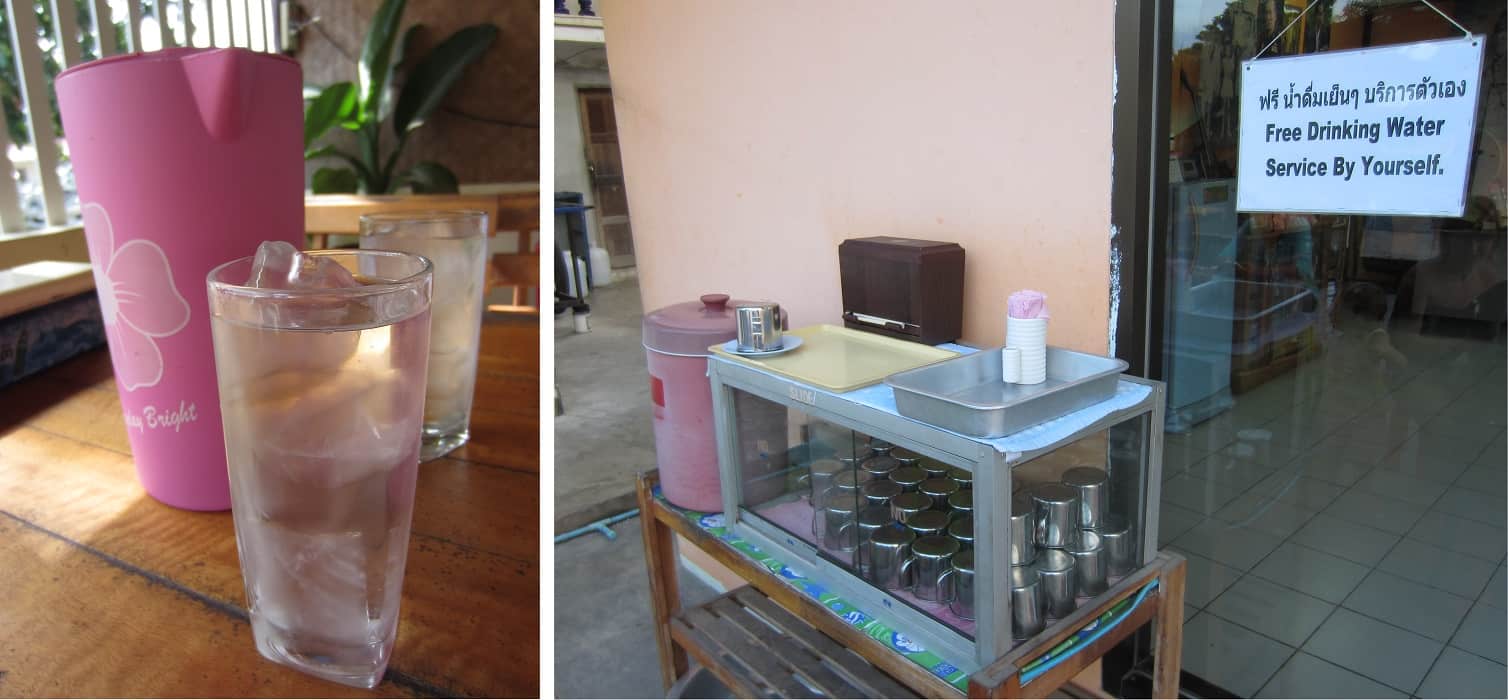 We discovered that a few restaurants sold water in glass bottles that are returned to the manufacturer for refilling. We did talk about buying water at these restaurants to fill up our water bottles if we ran out, but in the end we didn’t need to.
We discovered that a few restaurants sold water in glass bottles that are returned to the manufacturer for refilling. We did talk about buying water at these restaurants to fill up our water bottles if we ran out, but in the end we didn’t need to.
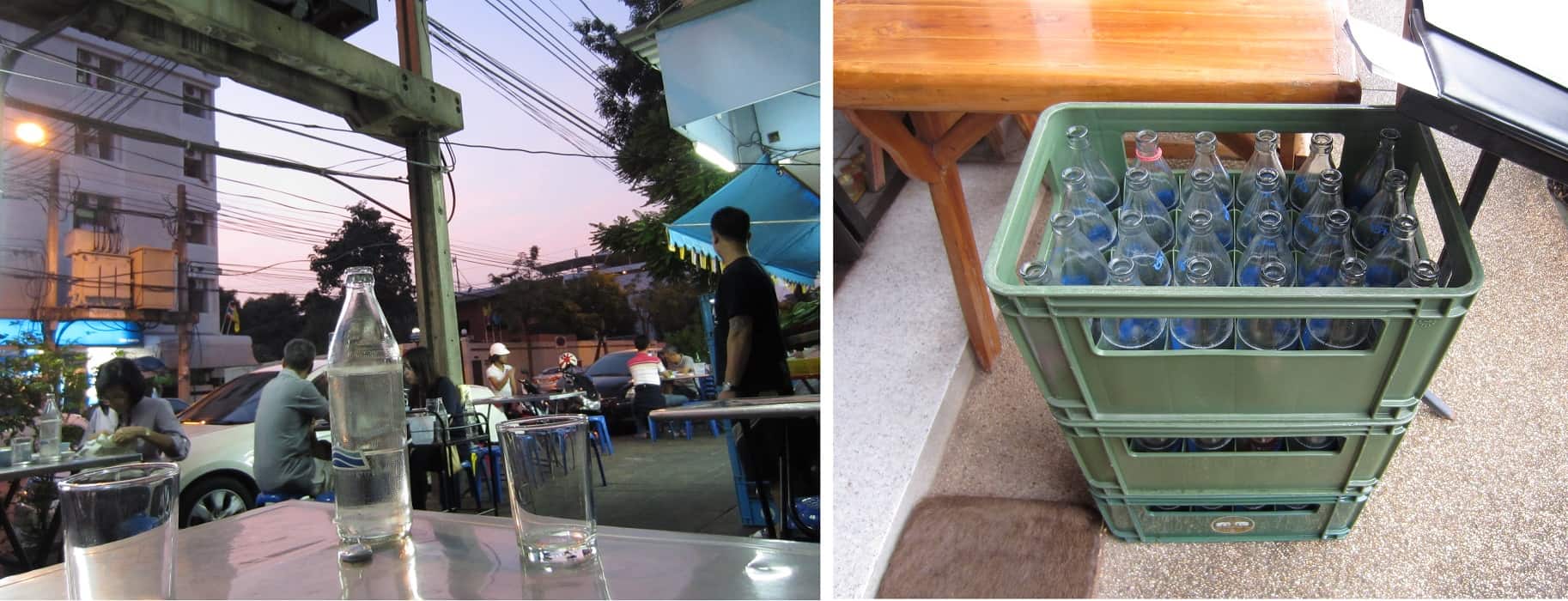
We did also see some water vending machines on the streets which filled empty containers. Our only issue was that the instructions were written entirely in Thai and we couldn’t understand how they worked. If we hadn’t found any other alternatives, we’d have popped some coins in the slot to see what happened, but as it turned out, we didn’t need to use these. It’s good to know that alternatives exist, though.
Reap the Rewards
We were completely prepared to pay extra in order to avoid using plastic; we figured it was worth it to limit our impact on the environment. Usually, a higher cost is something that we have to accept for “doing the sustainable thing”. Actually, it ended up being much cheaper! The 20 litre drums of water cost less than a dollar to buy, and many places charged more for a 500ml bottle of water, particularly outside of Bangkok. It was great not to contribute unnecessarily to landfill and keep our plastic-free pledge, and awesome to save money in the process!
Two people, four weeks away, and only one plastic bottle (reused several times before being responsibly recycled). Going plastic-free is just as possible abroad as it is at home if you put your mind to it!
[leadpages_leadbox leadbox_id=1429a0746639c5] [/leadpages_leadbox]
Ah. Four weeks away from it all. It was fantastic. I finally managed to slow down, take the time to relax properly and have a well-needed rest. I’m feeling so much better as a result.
That’s not to say I took time out from trying to live as sustainably as possible, keeping things simple and continuing to embrace minimalism. After all, why should holidaying change anything?
Having spent four weeks with a small backpack weighing less than 6kgs, and not feeling once like I was without something I needed, I am sold on the idea of taking as little as possible when travelling. It was such a great feeling not to be burdened by a huge heavy backpack, and it certainly made traveling around much more enjoyable. Read more
In less than 12 hours, I’ll be on my way to the airport for a month-long break overseas. It’s not my first trip abroad, or course, but it is the first time since I really started embracing the sustainability path. The last time I went overseas I hadn’t taken part in Plastic Free July (or given up plastic), I wasn’t passionate about reducing waste, I’d never heard of simple living and i thought minimalism was a furniture/design style.
Fast forward 18 months, and all of these things have become really important to me. I don’t want my ideals to go out of the window just because I’m going on holiday, although it would be much easier to take a break from all of that too.
I have decided to pack as lightly as I can. Having been on numerous trips where I’ve taken far too much and cussed as I’ve had to haul heavy luggage all about the place, this is something I’ve been working on for years. Read more
Do you ever get yourself into a situation, and wonder how on earth it was that you ever agreed to get involved in the first place? This time last week, that was me. You may have noticed (from the distinct lack of personal photographs on the blog) that I’m not a particular fan of having my picture taken. So how was it that I agreed to be photographed last Monday morning wearing a pair of overalls, sitting in a knitted (yarnbombed) wheelbarrow, clutching a live chicken?
Well…
Let me tell you about the Less is More Festival. Read more
So we’re off to Thailand in just over a week for a long-overdue rest and holiday. We’re flying there. You don’t need to tell me that flying is not a very sustainable form of transport. When I lived in England I was very disapproving of flying. Then I met my partner, an Australian, and moved out here, and it changed my perspective a little.
The first thing I had to reconsider was that wherever in the world we lived, one half of our family would be the other side of the world. Neither of us are prepared to never see our families again in order to try to combat climate change. Have you heard of food miles? Well there’s another concept, called “love miles”, which is the distance that we need to travel in order to see our friends and family and loved ones.
Before flying existed, or until it became affordable for the masses, most people would marry and remain within their communities and wouldn’t need to travel very far. I’m sure in the future, indeed I hope in the future, that flying will become so unaffordable or undesirable that this becomes the case once again, as people re-embrace their local communities. In the meantime, it is very cheap and easy to fly anywhere in the world and for most people, our love miles are pretty high.
The other thing I discovered when I moved here is that Australia is very far away from everything (and everyone) else. Even the other side of the same country is a few hours by flying, or a few days by driving. Having lived all my life in Europe, I have been spoiled. I could travel by boat or by train, or even drive, and reach numerous different countries in a matter of hours. I didn’t need to fly to see ancient ruins, buzzing modern cities, and beautiful rural landscapes, or to visit snow-capped mountains or golden beaches. I love experiencing different cultures; it makes me feel more connected to the world and travelling inspires me. In Europe it’s at your fingertips; here in Australia, it is not.
So I’ve come to accept that, living in Australia, I will probably need flying in my life, at least in the short-term.
What does this mean for the environment?
I was wondering, how much carbon will I be generating by flying to Thailand? And what can I do about it? I plugged all the info into a carbon calculator. My flight will generate 1 tonne of C02. Each way. And I’m going with my partner. So we’re generating 4 tonnes of C02, according to the calculator.
The website suggests that to offset this amount of carbon, I can pay $90, which will plant 24 trees.
I’m not really a fan of carbon offsetting. I feel like it’s a capitalist response to an environmental problem – paying money to alleviate guilt, or buying your way out of a situation. I feel like it benefits the wealthy, who can afford to pay to offset their travel more than others. I’m not completely convinced that it is the best way to help the environment. It seems so…detached. I have heard stories and worked at places that are involved with tree planting and investigated carbon trading, and my experience is that these organisations are committed to plant trees irrespective of whether they get funding by these schemes, although of course the money helps. But does it actually mean more trees get planted? Or does it mean that organisations can free up other funds to spend elsewhere? These carbon trading schemes are often run as businesses, too – so not all the money is going straight to tree-planting. I don’t like that aspect, either.
I may feel like these schemes are a little flawed, but that’s not to say that they aren’t still worthwhile. For people who are cash-rich, or time-poor, they offer a solution. And they’re making the concept of offsetting your flights easy and available to the general public. But I’m not going to be paying $90. I am, however, thinking about these 24 trees. I want to do something which I feel more accountable to. Ideally I’d like to plant my own trees. I’m wondering if there’s a local tree-planting scheme that I can get involved with (either when I’m in Thailand or back home). If that’s not possible, I hope to find a not-for-profit group to donate to where the money will go directly to local tree planting – trees that I can see.
Of course, not flying is still the best option, and I don’t intend to to be flying regularly. We don’t intend to go back to the UK every year, for example. I’ve also made a commitment not to use budget airlines, because I think that they are even more unsustainable than the bigger airlines. I don’t think flying should be cheap, and if governments didn’t allow airlines to avoid paying tax and fuel duty, it wouldn’t be. But as I now realise that I will be taking more flights over the coming years than I have in the past, I need to come up with some way of mitigating my cost to the environment in the best way that I can.
Starting with twenty-four trees.
You may remember that I wrote a post in September about how my life was going to be ridiculously busy over the coming three months? And how I was hoping that I’d be able to juggle everything successfully? Well, it hasn’t quite been the plain sailing that I’d hoped. I knew it was going to be a challenge, and whilst I was hopeful that I could manage everything, I knew it was a long shot. In fact it’s been super hectic and stressful, and of course some things have had to give. One of those things has been the blog. I haven’t been posting as frequently as usual because I’ve been so busy.
Fortunately, the end is in sight and we are due to go on a long (four week) holiday in just under two weeks. Bliss. Of course it would probably be a little less stressful if we’d actually done something in the way of preparations other than make sure our passports were valid and book flights, but no matter. Next Friday night we will be off, and leaving all this busy whirring spinning busy-ness behind us. Read more
When I started this blog, I was motivated because I felt like I was at a real turning point in my life. I was on a journey… a journey that started with a bigger commitment to being more sustainable, but became so much more than that. It has led me down all sorts of interesting paths. I felt like I was learning so much, and I really wanted to share what I was finding out, as well as keep a kind-of record of my progress.
I love being able to share what I know, and as part of that I got involved with Living Smart, a not-for-profit organisation based in Australia that provides practical knowledge and skills for people to live more sustainable lives. Read more
Lindsay Miles is an educator, speaker, author and passionate zero waste/plastic-free living advocate helping others live more meaningful lives with less waste and less stuff. She has been sharing ideas, tips, tricks and strategies on her website Treading My Own Path since 2013. Her first book, Less Stuff, was published in 2019 and her second, The Less Waste No Fuss Kitchen was published in June 2020. Originally from the UK, Lindsay now lives in Perth, Western Australia.
This site uses cookies. Cookies enable me to personalise your experience on this site so I can improve my content and communications.
I'm okay with thatWe may request cookies to be set on your device. We use cookies to let us know when you visit our websites, how you interact with us, to enrich your user experience, and to customize your relationship with our website.
Click on the different category headings to find out more. You can also change some of your preferences. Note that blocking some types of cookies may impact your experience on our websites and the services we are able to offer.
These cookies are strictly necessary to provide you with services available through our website and to use some of its features.
Because these cookies are strictly necessary to deliver the website, refusing them will have impact how our site functions. You always can block or delete cookies by changing your browser settings and force blocking all cookies on this website. But this will always prompt you to accept/refuse cookies when revisiting our site.
We fully respect if you want to refuse cookies but to avoid asking you again and again kindly allow us to store a cookie for that. You are free to opt out any time or opt in for other cookies to get a better experience. If you refuse cookies we will remove all set cookies in our domain.
We provide you with a list of stored cookies on your computer in our domain so you can check what we stored. Due to security reasons we are not able to show or modify cookies from other domains. You can check these in your browser security settings.
We also use different external services like Google Webfonts, Google Maps, and external Video providers. Since these providers may collect personal data like your IP address we allow you to block them here. Please be aware that this might heavily reduce the functionality and appearance of our site. Changes will take effect once you reload the page.
Google Webfont Settings:
Google Map Settings:
Google reCaptcha Settings:
Vimeo and Youtube video embeds:
You can read about our cookies and privacy settings in detail on our Privacy Policy Page.
Privacy Policy |
Join our community and you’ll receive free new content every week and a downloadable eBook “Enough is Enough” to help you take the next steps!Enough is Enough eBook
Please send me the eBook!
Send my eBook link to: By downloading the eBook you agree to my Privacy Policy. I hate spam as much as you do, and I promise to keep your email address safe. I will not share or sell your personal information, ever. You can unsubscribe at any time. This form collects information I will use to send out the free eBook, new content once a week and an occasional newsletter (with other stuff I think you’ll find useful such as events). |
